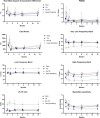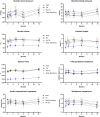Long-term effects of siponimod on cardiovascular and autonomic nervous system in secondary progressive multiple sclerosis
- PMID: 39364051
- PMCID: PMC11447318
- DOI: 10.3389/fphar.2024.1431380
Long-term effects of siponimod on cardiovascular and autonomic nervous system in secondary progressive multiple sclerosis
Abstract
Background: Siponimod, a second-generation, selective sphingosine 1-phosphate receptor (S1PR) 1 and 5 modulator, represents an important therapeutic choice for active secondary progressive multiple sclerosis (SPMS). Besides the beneficial immunomodulatory effects, siponimod impacts cardiovascular function through S1PR1 modulation. Short-term vagomimetic effects on cardiac activity have proved to be mitigated by dose titration. However, long-term consequences are less known.
Objectives: This study aimed to investigate the long-term impact of siponimod on cardiac autonomic modulation in people with SPMS (pwSPMS).
Methods: Heart rate variability (HRV) and vascular hemodynamic parameters were evaluated using Multiple Trigonometric Regressive Spectral analysis in 47 pwSPMS before siponimod therapy and after one, three, six and 12 months of treatment. Autonomic activation tests (tilt test for the sympathetic and deep breathing test for the parasympathetic cardiac modulation) were performed at each examination.
Results: pwSPMS preserved regular cardiovascular modulation responses during the autonomic tests reflected in the variation of several HRV parameters, such as RMSSD, pNN50, total power of HRV, high-frequency and low-frequency bands of the spectral domain or hemodynamic vascular parameters (Cwk, Zao, TPR, MAP) and baroreflex sensitivity (BRS). In the long-term follow-up, RMSSD, pNN50, total power, BRS and CwK presented a significant decrease, underlining a reduction of the parasympathetic and a shift towards sympathetic predominance in cardiac autonomic modulation that tends to stabilise after 1 year of treatment.
Conclusion: Due to dose titration, the short-term effects of siponimod on cardiac autonomic modulation are mitigated. The long-term impact on cardiac autonomic modulation is similar to fingolimod. The autonomic activation tests showed normal cardiovascular responses during 1-year follow-up in pwSPMS, confirming the safety profile of siponimod. Further research on autonomic function could reveal whether the observed sympathetic activation is a compensatory response to S1P signaling intervention or a feature of the disease, while also shedding light on the role of S1PR modulation in MS.
Keywords: autonomic nervous system modulation; baroreflex sensitivity; cardiovascular effect; multiple sclerosis; siponimod.
Copyright © 2024 Constantinescu, Haase, Akgün and Ziemssen.
Conflict of interest statement
KA received personal compensation for oral presentations and consulting services from Novartis, BMS, Merck, Teva, and Roche. TZ has received consulting fees, grants, and research support from various pharmaceutical companies, e.g., Almirall, Bayer, Biogen, Gen-zyme, Merck, Novartis, Roche, Sanofi, and Teva. The remaining authors declare that the research was conducted in the absence of any commercial or financial relationships that could be construed as a potential conflict of interest.
Figures


Similar articles
-
S1P receptor modulators and the cardiovascular autonomic nervous system in multiple sclerosis: a narrative review.Ther Adv Neurol Disord. 2022 Nov 22;15:17562864221133163. doi: 10.1177/17562864221133163. eCollection 2022. Ther Adv Neurol Disord. 2022. PMID: 36437849 Free PMC article. Review.
-
Short- and long-term effects of siponimod on autonomic nervous system in secondary progressive multiple sclerosis.Mult Scler Relat Disord. 2022 Aug;64:103966. doi: 10.1016/j.msard.2022.103966. Epub 2022 Jun 14. Mult Scler Relat Disord. 2022. PMID: 35724530
-
Fingolimod initiation in multiple sclerosis patients is associated with potential beneficial cardiovascular autonomic effects.Ther Adv Neurol Disord. 2017 Apr;10(4):191-209. doi: 10.1177/1756285616682936. Epub 2017 Jan 6. Ther Adv Neurol Disord. 2017. PMID: 28507603 Free PMC article.
-
Sphingosine-1-Phosphate (S1P) and S1P Signaling Pathway Modulators, from Current Insights to Future Perspectives.Cells. 2022 Jun 29;11(13):2058. doi: 10.3390/cells11132058. Cells. 2022. PMID: 35805142 Free PMC article. Review.
-
Autonomic nervous system abnormalities predict cardiovascular changes after initiation of siponimod in secondary progressive multiple sclerosis.Clin Neurophysiol. 2021 Feb;132(2):581-585. doi: 10.1016/j.clinph.2020.11.022. Epub 2021 Jan 15. Clin Neurophysiol. 2021. PMID: 33461086
Cited by
-
Unmasking the Silent Threat: Prevalence of Cardiovascular Risk Factors in MS Patients in Bucharest, Romania.J Clin Med. 2025 Mar 15;14(6):2001. doi: 10.3390/jcm14062001. J Clin Med. 2025. PMID: 40142809 Free PMC article.
-
p21-Activated Kinase 1 (Pak1) as an Element in Functional and Dysfunctional Interplay Among the Myocardium, Adipose Tissue, and Pancreatic Beta Cells.Compr Physiol. 2025 Apr;15(2):e70006. doi: 10.1002/cph4.70006. Compr Physiol. 2025. PMID: 40065530 Free PMC article. Review.
References
-
- Akbulak R. Ö., Rosenkranz S. C., Schaeffer B. N., Pinnschmidt H. O., Willems S., Heesen C., et al. (2018). Acute and long-term effects of fingolimod on heart rhythm and heart rate variability in patients with multiple sclerosis. Mult. Scler. Relat. Disord. 19, 44–49. 10.1016/j.msard.2017.10.020 - DOI - PubMed
LinkOut - more resources
Full Text Sources

